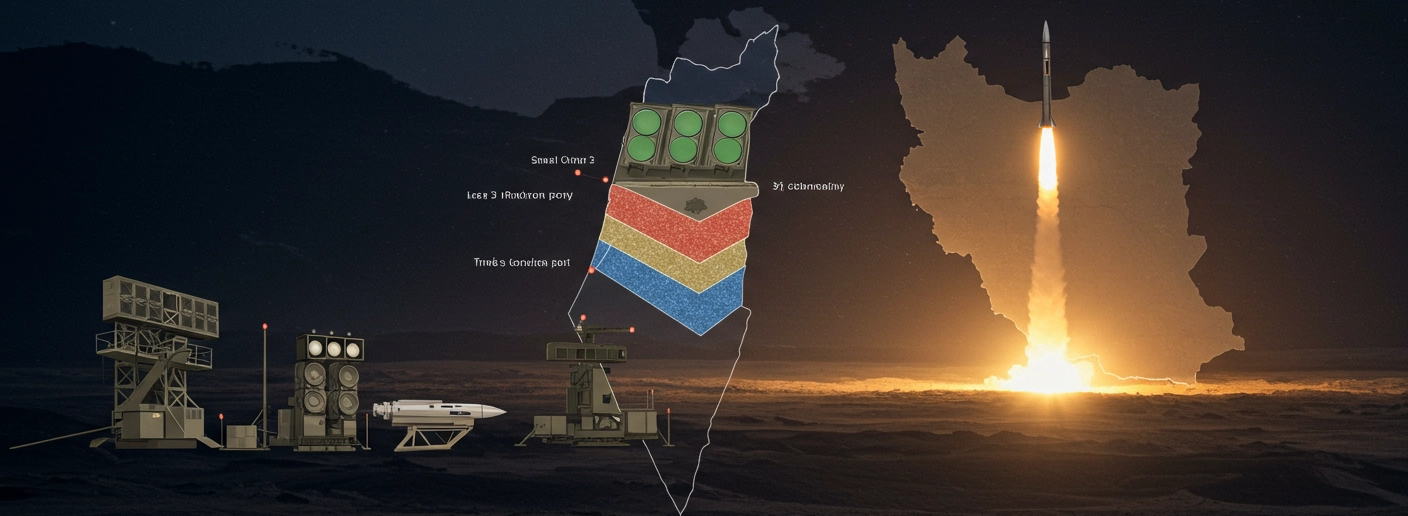
Israel's Multi-Layered Missile Defense: How It Counters Iranian Threats
In the past few days, Israel successfully utilized its cutting-edge air defense systems to counter an unprecedented wave of missile and drone attacks launched by Iran, as tensions between the two regional powers sharply escalated.
According to an Israeli military spokesperson, these systems achieved an impressive interception success rate of 80–90%, although some Iranian projectiles did breach the defenses—a reminder that no system guarantees complete protection.
This raises an important question:
What are the key Israeli defense systems responsible for this performance?
1. Iron Dome (Kipat Barzel)
Purpose:
Designed to intercept short-range rockets, artillery shells, and mortar rounds.
Development:
-
Developed by Rafael Advanced Defense Systems with heavy funding and technical support from the United States.
-
Entered service in 2011.
Capabilities:
-
Specializes in neutralizing short-range threats such as Katyusha rockets historically fired by Hamas and Hezbollah.
-
Features automated decision-making: The system calculates where a rocket will land; if the projectile is heading for an uninhabited area, it allows it to fall harmlessly.
Components:
-
EL/M-2084 radar (detection and tracking).
-
Battle management & control system.
-
3 Launchers, each loaded with 20 Tamir interceptors.
Naval Version:
-
In 2017, Israel deployed the naval Iron Dome ("C-Dome") to protect military ships and offshore assets such as gas rigs.
2. David’s Sling (Magic Wand)
Purpose:
Aimed at intercepting medium- to long-range missiles, cruise missiles, and unmanned aerial vehicles (UAVs).
Development:
-
Joint project between Rafael and RTX Corporation (formerly Raytheon) of the United States.
-
Deployed operationally in 2017.
Capabilities:
-
Designed to engage missile threats ranging between 100 to 200 kilometers.
-
Can track and intercept a wide variety of threats including aircraft, drones, and maneuvering cruise missiles.
-
Relies on a powerful Israeli-developed radar capable of:
-
Tracking up to 1,200 airborne targets at a time within a 474 km radius.
-
Monitoring 200 targets per minute.
-
Structure:
-
Three defense layers to counteract threats from various ranges and altitudes.
3. Arrow System (Hetz)
Purpose:
Israel’s strategic shield against long-range ballistic missiles, particularly those designed by Iran.
Development:
-
Co-developed by Israel Aerospace Industries (IAI) and the U.S. Missile Defense Agency.
-
Comprises Arrow 2 and Arrow 3 variants.
-
Specifically engineered to counter Iranian threats.
Capabilities:
-
Intercepts ballistic missiles outside Earth’s atmosphere (exo-atmospheric interception).
-
Effective against missiles traveling thousands of kilometers—capable of engaging targets at ranges exceeding 2,400 km.
-
Protects critical military, industrial, and civilian infrastructure.
Arrow 3:
-
The most advanced version.
-
Performs complex tasks such as discrimination between real warheads and decoys.
-
Provides interception beyond the atmosphere, reducing risks of debris falling in populated areas.
Challenges & Limitations:
-
Iran's missile arsenal includes sophisticated, fast-moving, and sometimes maneuverable projectiles (like the Shahab and Fateh series), which are designed to overwhelm or evade defense systems.
-
Saturation attacks (launching dozens or hundreds of missiles simultaneously) could stress even the most sophisticated multi-layered defenses.
In Summary:
| System | Threat Type | Range | Special Features |
|---|---|---|---|
| Iron Dome | Rockets, artillery shells | Short (<70 km) | Automated intercept, selective engagement, naval variant |
| David’s Sling | Missiles, UAVs, cruise missiles | Medium (100–200 km) | Multi-target tracking, adaptable engagement |
| Arrow 2/3 | Ballistic missiles (ICBM) | Long (>2,400 km) | Exo-atmospheric interception, decoy discrimination |
Conclusion:
Israel’s multi-layered missile defense system—combining the Iron Dome, David’s Sling, and Arrow systems—has proven highly effective during the recent Iranian missile barrage. This integrated shield allows Israel to address a broad range of airborne threats from short-range rockets to intercontinental ballistic missiles, although the possibility of leakage remains.
Future Prospects:
Israel continues to upgrade its defenses with laser-based systems (like Iron Beam) and deeper U.S. cooperation to prepare for increasingly complex threats.